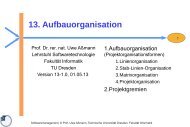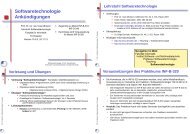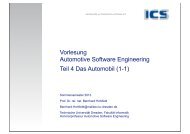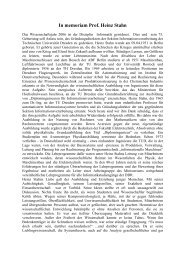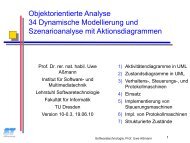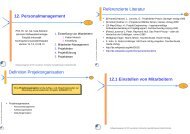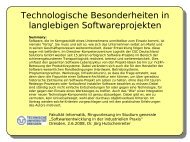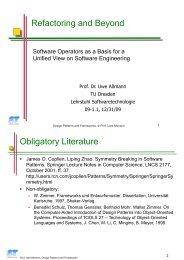How to Analyze Graph-Based Models - Www-st.inf.tu-dresden.de ...
How to Analyze Graph-Based Models - Www-st.inf.tu-dresden.de ...
How to Analyze Graph-Based Models - Www-st.inf.tu-dresden.de ...
You also want an ePaper? Increase the reach of your titles
YUMPU automatically turns print PDFs into web optimized ePapers that Google loves.
<<strong>st</strong>rong>How</<strong>st</strong>rong> <<strong>st</strong>rong>to</<strong>st</strong>rong> <<strong>st</strong>rong>Analyze</<strong>st</strong>rong> <<strong>st</strong>rong>Graph</<strong>st</strong>rong>-<<strong>st</strong>rong>Based</<strong>st</strong>rong> <<strong>st</strong>rong>Mo<strong>de</strong>ls</<strong>st</strong>rong><br />
Prof. Dr. U. Aßmann<br />
Technische Universität Dres<strong>de</strong>n<br />
In<strong>st</strong>i<strong>tu</strong>t für Software- und Multimediatechnik<br />
Gruppe Softwaretechnologie<br />
http://www-<strong>st</strong>.<strong>inf</strong>.<strong>tu</strong>-<strong>dres<strong>de</strong>n</strong>.<strong>de</strong><br />
Softwaretechnologie II, © Prof. Uwe Aßmann<br />
1
Contents<br />
► Different kinds of relations: Li<strong>st</strong>s, Trees, Dags, <<strong>st</strong>rong>Graph</<strong>st</strong>rong>s<br />
► Treating graph-based mo<strong>de</strong>ls – The graph-logic isomorphism<br />
► Analysis, querying, searching graph-based mo<strong>de</strong>ls<br />
♦ The Same Generation Problem<br />
♦ Datalog and EARS<br />
♦ Transitive Closure<br />
► Consi<strong>st</strong>ency checking of graph-based specifications<br />
■ Projections of graphs<br />
■ Transformation of graphs<br />
Prof. Uwe Aßmann, Softwaretechnologie II<br />
2
Obliga<<strong>st</strong>rong>to</<strong>st</strong>rong>ry Reading<br />
► Jazayeri Chap 3<br />
► If you have Macasziek or Pfleeger, read the lec<strong>tu</strong>re sli<strong>de</strong>s carefully<br />
and do the exercise sheets<br />
Prof. Uwe Aßmann, Softwaretechnologie II<br />
3
References<br />
► S. Ceri, G. Gottlob, L. Tanca. What You Always Wanted <<strong>st</strong>rong>to</<strong>st</strong>rong> Know<br />
About Datalog (And Never Dared <<strong>st</strong>rong>to</<strong>st</strong>rong> Ask). IEEE Transactions on<br />
Knowledge And Data Engineering. March 1989, (1) 1, pp. 146-166.<br />
► S. Ceri, G. Gottlob, L. Tanca. Logic Programming and Databases.<br />
Springer, 1989.<br />
► Ullman, J. D. Principles of Database and Knowledge Base Sy<strong>st</strong>ems.<br />
Computer Science Press 1989.<br />
► Preprints available on my home page:<br />
■ U. Aßmann. <<strong>st</strong>rong>Graph</<strong>st</strong>rong> Rewrite Sy<strong>st</strong>ems for Program Optimization. ACM<br />
Transactions on Programming Languages and Sy<strong>st</strong>ems, June 2000.<br />
■ U. Aßmann. OPTIMIX, A Tool for Rewriting and Optimizing Programs.<br />
<<strong>st</strong>rong>Graph</<strong>st</strong>rong> Grammar Handbook, Vol. II, 1999. Chapman&Hall.<br />
■ U. Aßmann. Reuse in Semantic Applications. REWERSE Summer<br />
School. July 2005. Malta. LNCS, Springer.<br />
Prof. Uwe Aßmann, Softwaretechnologie II<br />
4
Goals<br />
► Un<strong>de</strong>r<strong>st</strong>and that software mo<strong>de</strong>ls can become very large<br />
► Un<strong>de</strong>r<strong>st</strong>and the need for appropriate techniques <<strong>st</strong>rong>to</<strong>st</strong>rong> handle large<br />
mo<strong>de</strong>ls<br />
■ in hand <strong>de</strong>velopment<br />
■ au<<strong>st</strong>rong>to</<strong>st</strong>rong>matic analysis of the mo<strong>de</strong>ls<br />
► Learn how <<strong>st</strong>rong>to</<strong>st</strong>rong> use graph-based techniques (Datalog, Description<br />
Logic, EARS, graph transformations) <<strong>st</strong>rong>to</<strong>st</strong>rong> analyze and check mo<strong>de</strong>ls<br />
► Un<strong>de</strong>r<strong>st</strong>and some basic concepts of simplicity in software mo<strong>de</strong>ls<br />
Prof. Uwe Aßmann, Softwaretechnologie II<br />
5
Motivation<br />
► Software engineers mu<strong>st</strong> be able <<strong>st</strong>rong>to</<strong>st</strong>rong><br />
■ handle big <strong>de</strong>sign specifications (<strong>de</strong>sign mo<strong>de</strong>ls) during <strong>de</strong>velopment<br />
■ work with consi<strong>st</strong>ent mo<strong>de</strong>ls<br />
■ measure mo<strong>de</strong>ls and implementations<br />
■ validate mo<strong>de</strong>ls and implementations<br />
► Real mo<strong>de</strong>ls and sy<strong>st</strong>ems become very complex<br />
► Mo<strong>st</strong> specifications are graph-based<br />
■ We have <<strong>st</strong>rong>to</<strong>st</strong>rong> <strong>de</strong>al with basic graph theory <<strong>st</strong>rong>to</<strong>st</strong>rong> be able <<strong>st</strong>rong>to</<strong>st</strong>rong> measure well<br />
► Every analysis method is very welcome<br />
► Every <strong>st</strong>ruc<strong>tu</strong>ring method is very welcome<br />
Prof. Uwe Aßmann, Softwaretechnologie II<br />
6
The Problem:<br />
<<strong>st</strong>rong>How</<strong>st</strong>rong> <<strong>st</strong>rong>to</<strong>st</strong>rong> Ma<strong>st</strong>er Large <<strong>st</strong>rong>Mo<strong>de</strong>ls</<strong>st</strong>rong><br />
► Large mo<strong>de</strong>ls have large graphs<br />
► They can be hard <<strong>st</strong>rong>to</<strong>st</strong>rong> un<strong>de</strong>r<strong>st</strong>and<br />
► Figures taken from Goose Reengineering Tool, analysing a Java<br />
class sy<strong>st</strong>em [Goose, FZI Karlsruhe]<br />
Prof. Uwe Aßmann, Softwaretechnologie II<br />
7
Prof. Uwe Aßmann, Softwaretechnologie II<br />
8
Partially Collapsed<br />
Prof. Uwe Aßmann, Softwaretechnologie II<br />
9
Totally Collapsed<br />
Prof. Uwe Aßmann, Softwaretechnologie II<br />
10
Requirements for Mo<strong>de</strong>lling in Requirements and<br />
Design<br />
► We need gui<strong>de</strong>lines how <<strong>st</strong>rong>to</<strong>st</strong>rong> <strong>de</strong>velop simple mo<strong>de</strong>ls<br />
► We need analysis techniques <<strong>st</strong>rong>to</<strong>st</strong>rong><br />
■ Check the consi<strong>st</strong>ency of the mo<strong>de</strong>ls<br />
■ Find out about their complexity<br />
■ Find out about simplifications<br />
Prof. Uwe Aßmann, Softwaretechnologie II<br />
11
Some Relationships (<<strong>st</strong>rong>Graph</<strong>st</strong>rong>s) in<br />
Software Sy<strong>st</strong>ems<br />
Softwaretechnologie II, © Prof. Uwe Aßmann<br />
12
Example: Rename Refac<<strong>st</strong>rong>to</<strong>st</strong>rong>rings in Programs<br />
<<strong>st</strong>rong>How</<strong>st</strong>rong> <<strong>st</strong>rong>to</<strong>st</strong>rong> change the name of variable Foo and keep the program consi<strong>st</strong>ent?<br />
Refac<<strong>st</strong>rong>to</<strong>st</strong>rong>r the name Person <<strong>st</strong>rong>to</<strong>st</strong>rong> Human:<br />
class Person { .. }<br />
class Course {<br />
}<br />
Person teacher = new Person(“Jim”);<br />
Person <strong>st</strong>u<strong>de</strong>nt = new Person(“John”);<br />
class Human { .. }<br />
class Course {<br />
}<br />
Human teacher = new Human(“Jim”);<br />
Human <strong>st</strong>u<strong>de</strong>nt = new Human(“John”);<br />
Definition<br />
Reference (Use)<br />
Prof. Uwe Aßmann, Softwaretechnologie II<br />
13
Definition-Use <<strong>st</strong>rong>Graph</<strong>st</strong>rong>s (Def-Use <<strong>st</strong>rong>Graph</<strong>st</strong>rong>s)<br />
► Every language and notation has<br />
■ Definitions of items (also the variable Foo)<br />
■ Uses of items (references <<strong>st</strong>rong>to</<strong>st</strong>rong> Foo)<br />
► This is because we talk in specifications about names of objects and<br />
their use<br />
■ Definitions are done in a data <strong>de</strong>finition language (DDL)<br />
■ Uses are part of a data manipulation language (DML)<br />
► Starting from the ab<strong>st</strong>ract syntax, the name analysis finds out about<br />
the <strong>de</strong>finitions, uses, and their relations (the Def-Use graph)<br />
■ Def-Use graphs exi<strong>st</strong> in every language!<br />
■ <<strong>st</strong>rong>How</<strong>st</strong>rong> <<strong>st</strong>rong>to</<strong>st</strong>rong> specify the name analysis, i.e., the <strong>de</strong>f-use graph?<br />
Prof. Uwe Aßmann, Softwaretechnologie II<br />
14
Refac<<strong>st</strong>rong>to</<strong>st</strong>rong>ring on Def-Use <<strong>st</strong>rong>Graph</<strong>st</strong>rong>s<br />
► For renaming of a <strong>de</strong>finition, all uses have <<strong>st</strong>rong>to</<strong>st</strong>rong> be changed, <<strong>st</strong>rong>to</<strong>st</strong>rong>o<br />
■ We need <<strong>st</strong>rong>to</<strong>st</strong>rong> trace all uses of a <strong>de</strong>finition in the Def-Use-graph<br />
■ Refac<<strong>st</strong>rong>to</<strong>st</strong>rong>ring works always on Def-Use-graphs<br />
► Refac<<strong>st</strong>rong>to</<strong>st</strong>rong>ring works always in the same way:<br />
■ Change a <strong>de</strong>finition<br />
■ Find all <strong>de</strong>pen<strong>de</strong>nt references<br />
■ Change them<br />
■ Recurse handling other <strong>de</strong>pen<strong>de</strong>nt <strong>de</strong>finitions<br />
► Refac<<strong>st</strong>rong>to</<strong>st</strong>rong>ring can be supported by <<strong>st</strong>rong>to</<strong>st</strong>rong>ols<br />
■ The Def-Use-graph forms the basis of refac<<strong>st</strong>rong>to</<strong>st</strong>rong>ring <<strong>st</strong>rong>to</<strong>st</strong>rong>ols<br />
► <<strong>st</strong>rong>How</<strong>st</strong>rong>ever, building the Def-Use-<<strong>st</strong>rong>Graph</<strong>st</strong>rong> for a complete program co<strong>st</strong>s a<br />
lot of space and is a difficult program analysis task<br />
■ Every method that <strong>st</strong>ruc<strong>tu</strong>res the Def-Use-<<strong>st</strong>rong>Graph</<strong>st</strong>rong> benefits immediately the<br />
refac<<strong>st</strong>rong>to</<strong>st</strong>rong>ring<br />
■ either simplifying or accelerating it<br />
Prof. Uwe Aßmann, Softwaretechnologie II<br />
15
Control-Flow <<strong>st</strong>rong>Graph</<strong>st</strong>rong>s<br />
► Describe the control flow in a program<br />
► Typically, if <strong>st</strong>atements and switch <strong>st</strong>atements split control flow<br />
► Their ends join control flow<br />
► Ne<strong>st</strong>ed loops are <strong>de</strong>scribed by ne<strong>st</strong>ed control flow graphs<br />
a+=5;<br />
print a<br />
if<br />
re<strong>tu</strong>rn<br />
while<br />
print a++<br />
Prof. Uwe Aßmann, Softwaretechnologie II<br />
16
Data-Flow <<strong>st</strong>rong>Graph</<strong>st</strong>rong>s<br />
► Describe the flow of data through the variables<br />
a=a+5;<br />
print a<br />
a=0<br />
if<br />
b=a<br />
while<br />
print a++<br />
Prof. Uwe Aßmann, Softwaretechnologie II<br />
17
Simple (Flow-Insensitive) Call <<strong>st</strong>rong>Graph</<strong>st</strong>rong><br />
► Describe the call relationship between the procedures<br />
main = procedure () {<br />
array int[] a = read();<br />
print(a);<br />
quicksort(a);<br />
print(a);<br />
}<br />
quicksort = procedure(a: array[0..n]) {<br />
int pivot = searchPivot(a);<br />
quicksort(a[0], a[pivot-1]);<br />
quicksort(a[pivot+1,n]);<br />
}<br />
read<br />
print<br />
searchPivot<br />
main<br />
quicksort<br />
Prof. Uwe Aßmann, Softwaretechnologie II<br />
18
Precise Call <<strong>st</strong>rong>Graph</<strong>st</strong>rong><br />
► Describe the call relationship between the procedures including call<br />
sites<br />
read<br />
1<br />
print<br />
main<br />
2<br />
1<br />
quicksort<br />
searchPivot<br />
2<br />
Prof. Uwe Aßmann, Softwaretechnologie II<br />
19
UML <<strong>st</strong>rong>Graph</<strong>st</strong>rong>s<br />
► All diagram sublanguages of UML are graphs<br />
► They can be analyzed and checked with graph techniques<br />
► Hence, graph techniques are an essential <<strong>st</strong>rong>to</<strong>st</strong>rong>ol of the software<br />
engineer<br />
Prof. Uwe Aßmann, Softwaretechnologie II<br />
20
Types of <<strong>st</strong>rong>Graph</<strong>st</strong>rong>s in Specifications<br />
Li<strong>st</strong>s, Trees, Dags, <<strong>st</strong>rong>Graph</<strong>st</strong>rong>s<br />
[not presented, only for completeness]<br />
Softwaretechnologie II, © Prof. Uwe Aßmann<br />
21
Mo<strong>de</strong>lling <<strong>st</strong>rong>Graph</<strong>st</strong>rong>s on Two Ab<strong>st</strong>raction Levels<br />
► We <strong>de</strong>al here mo<strong>st</strong>ly with directed graphs (digraphs)<br />
■ li<strong>st</strong>s, trees, dags, (di-)graphs<br />
► There are two different ab<strong>st</strong>raction levels; we are intere<strong>st</strong>ed in the<br />
logical level:<br />
► Logical level (ab<strong>st</strong>ract, often <strong>de</strong>clarative, problem oriented)<br />
■ Data type Li<strong>st</strong>, Tree, Dag, <<strong>st</strong>rong>Graph</<strong>st</strong>rong><br />
■ Methods <<strong>st</strong>rong>to</<strong>st</strong>rong> handle graphs:<br />
♦ Relational algebra<br />
♦ Datalog<br />
♦ Description logic<br />
♦ <<strong>st</strong>rong>Graph</<strong>st</strong>rong> rewriting<br />
♦ <<strong>st</strong>rong>Graph</<strong>st</strong>rong> grammars<br />
♦ Recursion schemas<br />
► Physical level (concrete, often imperative, machine oriented)<br />
■ Data type adjacency li<strong>st</strong>, boolean (bit)matrix,<br />
■ Imperative algorithms<br />
■ Pointer based algorithms<br />
Prof. Uwe Aßmann, Softwaretechnologie II<br />
22
Definitions<br />
► Fan-in<br />
■ In-<strong>de</strong>gree of no<strong>de</strong> un<strong>de</strong>r a certain relation<br />
■ Fan-in(n = 0): n is root no<strong>de</strong> (source)<br />
■ Fan-in(n) > 0: n is reachable from other no<strong>de</strong>s<br />
► Fan-out<br />
► Path<br />
■ Out-<strong>de</strong>gree of no<strong>de</strong> un<strong>de</strong>r a certain relation<br />
■ Fan-out(n) = 0: n is leaf no<strong>de</strong> (sink)<br />
■ An inner no<strong>de</strong> is neither a root nor a leaf<br />
■ A path p = (n 1, n 2,…,n k) is a sequence of no<strong>de</strong>s of length k<br />
Prof. Uwe Aßmann, Softwaretechnologie II<br />
23
Li<strong>st</strong>s<br />
► One source (root)<br />
► One sink<br />
► Every other no<strong>de</strong> has fan-in 1,<br />
fan-out 1<br />
► Represents a <<strong>st</strong>rong>to</<strong>st</strong>rong>tal or<strong>de</strong>r<br />
(sequentialization)<br />
► Gives<br />
Prioritization<br />
Execution or<strong>de</strong>r<br />
root<br />
sink<br />
Prof. Uwe Aßmann, Softwaretechnologie II<br />
24
Trees<br />
► One source (root)<br />
► Many sinks (leaves)<br />
► Every no<strong>de</strong> has fan-in
Directed Acyclic <<strong>st</strong>rong>Graph</<strong>st</strong>rong>s<br />
► Many sources<br />
■ A jungle (term graph) is a dag<br />
with one root<br />
► Many sinks<br />
► Fan-in, fan-out arbitrary<br />
► Represents a partial or<strong>de</strong>r<br />
■ Less con<strong>st</strong>raints that in a <<strong>st</strong>rong>to</<strong>st</strong>rong>tal<br />
or<strong>de</strong>r<br />
► Weaker hierarchical ab<strong>st</strong>raction<br />
fea<strong>tu</strong>re<br />
■ Can be layered<br />
► Example<br />
■ UML inheritance dags<br />
.......<br />
.......<br />
sinks<br />
roots<br />
.......<br />
Prof. Uwe Aßmann, Softwaretechnologie II<br />
26
Directed <<strong>st</strong>rong>Graph</<strong>st</strong>rong>s (Digraphs)<br />
► Many roots<br />
■ A digraph with one source is<br />
called flow graph<br />
► Many sinks<br />
► Backedges and cycles<br />
► Wor<strong>st</strong> <strong>st</strong>ruc<strong>tu</strong>re<br />
► Example<br />
■ Many diagrammatic methods in<br />
Software Engineering<br />
■ UML class diagrams<br />
■ SA data flow diagrams<br />
.......<br />
.......<br />
sinks<br />
roots<br />
.......<br />
Prof. Uwe Aßmann, Softwaretechnologie II<br />
27
Skele<<strong>st</strong>rong>to</<strong>st</strong>rong>n Trees (Trees with Secondary <<strong>st</strong>rong>Graph</<strong>st</strong>rong>s)<br />
► Skele<<strong>st</strong>rong>to</<strong>st</strong>rong>n tree with links<br />
► Links are a secondary <strong>st</strong>ruc<strong>tu</strong>re<br />
■ Secondary relation is<br />
overlaid and is “less<br />
important”<br />
► Advantage<br />
■ Tree can be used as a<br />
concep<strong>tu</strong>al hierarchy<br />
■ References <<strong>st</strong>rong>to</<strong>st</strong>rong> other parts are<br />
possible<br />
► Example<br />
■ XML, e.g., XHTML<br />
■ Struc<strong>tu</strong>re is <strong>de</strong>scribed by<br />
Xschema/DTD, links form the<br />
secondary relations<br />
.......<br />
.......<br />
sinks<br />
roots<br />
.......<br />
Prof. Uwe Aßmann, Softwaretechnologie II<br />
28
Reducible <<strong>st</strong>rong>Graph</<strong>st</strong>rong>s (<<strong>st</strong>rong>Graph</<strong>st</strong>rong>s with Skele<<strong>st</strong>rong>to</<strong>st</strong>rong>n Trees)<br />
► <<strong>st</strong>rong>Graph</<strong>st</strong>rong> with cycles, however,<br />
only between si<strong>st</strong>ers<br />
■ No cycles between hierarchy<br />
levels<br />
► <<strong>st</strong>rong>Graph</<strong>st</strong>rong> can be “reduced” <<strong>st</strong>rong>to</<strong>st</strong>rong> one<br />
no<strong>de</strong><br />
► Advantage<br />
■ Tree can be used as a<br />
concep<strong>tu</strong>al hierarchy<br />
► Example<br />
■ UML <strong>st</strong>atecharts<br />
.......<br />
.......<br />
.......<br />
Prof. Uwe Aßmann, Softwaretechnologie II<br />
29
Layerable <<strong>st</strong>rong>Graph</<strong>st</strong>rong>s (<<strong>st</strong>rong>Graph</<strong>st</strong>rong>s with Skele<<strong>st</strong>rong>to</<strong>st</strong>rong>n Dags)<br />
► Like reducible graphs, however,<br />
sharing between different parts<br />
of the skele<<strong>st</strong>rong>to</<strong>st</strong>rong>n trees<br />
■ <<strong>st</strong>rong>Graph</<strong>st</strong>rong> cannot be “reduced”<br />
<<strong>st</strong>rong>to</<strong>st</strong>rong> one no<strong>de</strong><br />
► Advantage<br />
■ Skele<<strong>st</strong>rong>to</<strong>st</strong>rong>n can be used <<strong>st</strong>rong>to</<strong>st</strong>rong> layer<br />
the graph<br />
■ Cycles only within one layer<br />
► Example<br />
■ Layered sy<strong>st</strong>em architec<strong>tu</strong>res<br />
.......<br />
.......<br />
.......<br />
Prof. Uwe Aßmann, Softwaretechnologie II<br />
30
Strength of Assertions in <<strong>st</strong>rong>Mo<strong>de</strong>ls</<strong>st</strong>rong><br />
Li<strong>st</strong>: <strong>st</strong>rong assertion: <<strong>st</strong>rong>to</<strong>st</strong>rong>tal or<strong>de</strong>r<br />
Tree: <strong>st</strong>ill ab<strong>st</strong>raction possible<br />
Dag: <strong>st</strong>ill layering possible<br />
<<strong>st</strong>rong>Graph</<strong>st</strong>rong>: the wor<strong>st</strong> case<br />
Sequential<br />
Hierarchies<br />
Partial or<strong>de</strong>r<br />
Layered<br />
Un<strong>st</strong>ruc<strong>tu</strong>red<br />
Ease of<br />
Un<strong>de</strong>r<strong>st</strong>anding<br />
Prof. Uwe Aßmann, Softwaretechnologie II<br />
31
Strength of Assertions in <<strong>st</strong>rong>Mo<strong>de</strong>ls</<strong>st</strong>rong><br />
► Saying that a relation is<br />
■ A li<strong>st</strong>: very <strong>st</strong>rong assertion, <<strong>st</strong>rong>to</<strong>st</strong>rong>tal or<strong>de</strong>r!<br />
■ A tree: <strong>st</strong>ill a <strong>st</strong>rong assertion: hierarchies possible, easy <<strong>st</strong>rong>to</<strong>st</strong>rong> think<br />
■ A dag: <strong>st</strong>ill layering possible, <strong>st</strong>ill a partial or<strong>de</strong>r<br />
■ A graph: hopefully, some <strong>st</strong>ruc<strong>tu</strong>ring or analysis is possible. Otherwise,<br />
it’s the wor<strong>st</strong> case<br />
► And those propositions hold for every kind of diagram in Software<br />
Engineering!<br />
► Try <<strong>st</strong>rong>to</<strong>st</strong>rong> achieve dags, trees, or li<strong>st</strong>s in your specifications, mo<strong>de</strong>ls,<br />
and <strong>de</strong>signs<br />
■ Sy<strong>st</strong>ems will be easier, more efficient<br />
Prof. Uwe Aßmann, Softwaretechnologie II<br />
32
Struc<strong>tu</strong>ring Improves Wor<strong>st</strong> Case<br />
Li<strong>st</strong>: <strong>st</strong>rong assertion: <<strong>st</strong>rong>to</<strong>st</strong>rong>tal or<strong>de</strong>r<br />
Tree: <strong>st</strong>ill ab<strong>st</strong>raction possible<br />
Dag: <strong>st</strong>ill layering possible<br />
Struc<strong>tu</strong>red graph<br />
<<strong>st</strong>rong>Graph</<strong>st</strong>rong> with analyzed fea<strong>tu</strong>res<br />
<<strong>st</strong>rong>Graph</<strong>st</strong>rong>: the wor<strong>st</strong> case<br />
Sequential<br />
Hierarchies<br />
Partial or<strong>de</strong>r<br />
Layered<br />
Struc<strong>tu</strong>red<br />
Un<strong>st</strong>ruc<strong>tu</strong>red<br />
Un<strong>st</strong>ruc<strong>tu</strong>red<br />
Ease of<br />
Un<strong>de</strong>r<strong>st</strong>anding<br />
Prof. Uwe Aßmann, Softwaretechnologie II<br />
33
Remark: Text-based Specifications Have a<br />
<<strong>st</strong>rong>Graph</<strong>st</strong>rong>-<<strong>st</strong>rong>Based</<strong>st</strong>rong> Representation<br />
► Are parsed <<strong>st</strong>rong>to</<strong>st</strong>rong> ab<strong>st</strong>ract syntax trees (AST)<br />
► After name analysis, they become ab<strong>st</strong>ract syntax graphs (ASG)<br />
► Then the same remarks hold<br />
► Hence, all specifications are graph-based!<br />
mo<strong>de</strong>l M begin<br />
elements<br />
T: transis<<strong>st</strong>rong>to</<strong>st</strong>rong>r;<br />
R: resis<<strong>st</strong>rong>to</<strong>st</strong>rong>r;<br />
equations<br />
R = <strong>de</strong>r(T);<br />
end<br />
.......<br />
AST<br />
.......<br />
.......<br />
.......<br />
ASG<br />
.......<br />
.......<br />
Prof. Uwe Aßmann, Softwaretechnologie II<br />
34
Methods and Tools for<br />
Analysis of <<strong>st</strong>rong>Graph</<strong>st</strong>rong>-<<strong>st</strong>rong>Based</<strong>st</strong>rong> <<strong>st</strong>rong>Mo<strong>de</strong>ls</<strong>st</strong>rong><br />
Softwaretechnologie II, © Prof. Uwe Aßmann<br />
35
married<br />
The <<strong>st</strong>rong>Graph</<strong>st</strong>rong>-Logic Isomorphism<br />
► In the following, we will make use of the graph-logic isomorphism:<br />
► <<strong>st</strong>rong>Graph</<strong>st</strong>rong>s can be used <<strong>st</strong>rong>to</<strong>st</strong>rong> represent logic<br />
■ No<strong>de</strong>s correspond <<strong>st</strong>rong>to</<strong>st</strong>rong> con<strong>st</strong>ants<br />
■ (Directed) edges correspond <<strong>st</strong>rong>to</<strong>st</strong>rong> binary predicates<br />
■ Hyperedges (n-edges) correspond <<strong>st</strong>rong>to</<strong>st</strong>rong> n-ary predicates<br />
► Consequence:<br />
■ <<strong>st</strong>rong>Graph</<strong>st</strong>rong> algorithms can be used <<strong>st</strong>rong>to</<strong>st</strong>rong> te<strong>st</strong> logic queries on graphbased<br />
specifications<br />
■ <<strong>st</strong>rong>Graph</<strong>st</strong>rong> rewrite sy<strong>st</strong>ems can be used for <strong>de</strong>duction<br />
Carl Gu<strong>st</strong>av<br />
Silvia<br />
father<br />
mother<br />
Vic<<strong>st</strong>rong>to</<strong>st</strong>rong>ria<br />
married(CarlGu<strong>st</strong>av,Silvia).<br />
married(Silvia, CarlGu<strong>st</strong>av).<br />
father(CarlGu<strong>st</strong>av,Vic<<strong>st</strong>rong>to</<strong>st</strong>rong>ria).<br />
mother(Silvia,Vic<<strong>st</strong>rong>to</<strong>st</strong>rong>ria).<br />
Prof. Uwe Aßmann, Softwaretechnologie II<br />
36
<<strong>st</strong>rong>Graph</<strong>st</strong>rong>s and Fact Data Bases<br />
► <<strong>st</strong>rong>Graph</<strong>st</strong>rong>s can also be noted<br />
tex<strong>tu</strong>ally<br />
► <<strong>st</strong>rong>Graph</<strong>st</strong>rong>s consi<strong>st</strong> of no<strong>de</strong>s,<br />
relations<br />
► Relations link no<strong>de</strong>s<br />
isParentOf<br />
Adam<br />
isParentOf<br />
Sibylla<br />
Gu<strong>st</strong>avAdolf<br />
► Fact data bases consi<strong>st</strong> of<br />
con<strong>st</strong>ants (data) and<br />
predicates<br />
► No<strong>de</strong>s of graphs can be<br />
regar<strong>de</strong>d as con<strong>st</strong>ants, edges<br />
as predicates between<br />
con<strong>st</strong>ants (facts):<br />
isParentOf(Adam,Gu<strong>st</strong>avAdolf).<br />
isParentOf(Adam,Sibylla).<br />
Prof. Uwe Aßmann, Softwaretechnologie II<br />
37
Queries on <<strong>st</strong>rong>Graph</<strong>st</strong>rong>-<<strong>st</strong>rong>Based</<strong>st</strong>rong> <<strong>st</strong>rong>Mo<strong>de</strong>ls</<strong>st</strong>rong> Make Implicit<br />
Knowledge Explicit<br />
► Since graph-based mo<strong>de</strong>ls are a mess, we try <<strong>st</strong>rong>to</<strong>st</strong>rong> analyze them<br />
► Knowledge is either<br />
■ Explicit, I.e., represented in the mo<strong>de</strong>l as edges and no<strong>de</strong>s<br />
■ Implicit, I.e., hid<strong>de</strong>n, not directly represented, and mu<strong>st</strong> be analyzed<br />
► Query and analysis problems try <<strong>st</strong>rong>to</<strong>st</strong>rong> make implicit knowledge explicit<br />
■ E.g. Does the graph have one root? <<strong>st</strong>rong>How</<strong>st</strong>rong> many leaves do we have? Is<br />
this subgraph a tree? Can I reach that no<strong>de</strong> from this no<strong>de</strong>?<br />
► Determining fea<strong>tu</strong>res of no<strong>de</strong>s and edges<br />
■ Finding certain no<strong>de</strong>s, or patterns<br />
► Determining global fea<strong>tu</strong>res of the mo<strong>de</strong>l<br />
■ Finding paths between two no<strong>de</strong>s (e.g., connected, reachable)<br />
■ Finding paths that satisfy additional con<strong>st</strong>raints<br />
■ Finding subgraphs that satisfy additional con<strong>st</strong>raints<br />
Prof. Uwe Aßmann, Softwaretechnologie II<br />
38
Queries on <<strong>st</strong>rong>Graph</<strong>st</strong>rong>s Check Consi<strong>st</strong>ency<br />
► Queries can be used <<strong>st</strong>rong>to</<strong>st</strong>rong> find out whether a graph is consi<strong>st</strong>ent<br />
► Due <<strong>st</strong>rong>to</<strong>st</strong>rong> the graph-logic isomorphism, con<strong>st</strong>raint specifications can be<br />
phrased in logic and applied <<strong>st</strong>rong>to</<strong>st</strong>rong> graphs<br />
► Business people call con<strong>st</strong>raint specifications business rules<br />
► Example:<br />
■ if a person hasn't died yet, its <<strong>st</strong>rong>to</<strong>st</strong>rong>wn should not li<strong>st</strong> her in the li<strong>st</strong> of <strong>de</strong>ad<br />
people<br />
■ if a car is exported <<strong>st</strong>rong>to</<strong>st</strong>rong> England, <strong>st</strong>eering wheel and pedals should be on<br />
the right si<strong>de</strong>; otherwise on the left<br />
Prof. Uwe Aßmann, Softwaretechnologie II<br />
39
Example:<br />
<<strong>st</strong>rong>How</<strong>st</strong>rong> <<strong>st</strong>rong>to</<strong>st</strong>rong> <<strong>st</strong>rong>Analyze</<strong>st</strong>rong> a Sy<strong>st</strong>em for Layers<br />
And the Same Generation Problem<br />
<<strong>st</strong>rong>How</<strong>st</strong>rong> <<strong>st</strong>rong>to</<strong>st</strong>rong> query a dag and search in a dag<br />
<<strong>st</strong>rong>How</<strong>st</strong>rong> <<strong>st</strong>rong>to</<strong>st</strong>rong> layer a dag – a simple <strong>st</strong>ruc<strong>tu</strong>ring problem<br />
http://susning.nu/Drottning_Silvia<br />
Softwaretechnologie II, © Prof. Uwe Aßmann<br />
40
Layering of Sy<strong>st</strong>ems<br />
► To be comprehensible, a sy<strong>st</strong>em should be <strong>st</strong>ruc<strong>tu</strong>red in layers<br />
■ Several relations in a sy<strong>st</strong>em can be used <<strong>st</strong>rong>to</<strong>st</strong>rong> <strong>st</strong>ruc<strong>tu</strong>re it, e.g., the<br />
♦ Call graph: layered call graph<br />
♦ Layered <strong>de</strong>finition-use graph<br />
♦ Layered USES relationship<br />
► A layered architec<strong>tu</strong>re is the dominating<br />
<strong>st</strong>yle for large sy<strong>st</strong>ems<br />
► Outer, upper layers use inner, lower<br />
layers (USES relationship)<br />
► Legacy sy<strong>st</strong>ems can be analyzed for<br />
layering, and if they do not have a<br />
layered architec<strong>tu</strong>re, their <strong>st</strong>ruc<strong>tu</strong>re can<br />
be improved <<strong>st</strong>rong>to</<strong>st</strong>rong>wards this principle<br />
Prof. Uwe Aßmann, Softwaretechnologie II<br />
41
Layering of Acyclic <<strong>st</strong>rong>Graph</<strong>st</strong>rong>s<br />
► Given any acyclic relation, it can be ma<strong>de</strong> layered<br />
■ SameGeneration analysis layers in trees or dags<br />
► Example: layering a family tree:<br />
■ Who is whose contemporary?<br />
■ Who is ascendant of whom?<br />
Adam<br />
Gu<strong>st</strong>avAdolf<br />
Sibylla<br />
Walter<br />
Alice<br />
Desiree<br />
Carl Gu<strong>st</strong>av<br />
Ma<strong>de</strong>leine<br />
Silvia<br />
Ralf<br />
Vic<<strong>st</strong>rong>to</<strong>st</strong>rong>ria<br />
Prof. Uwe Aßmann, Softwaretechnologie II<br />
42
Pattern and Rules<br />
► Parenthood can be <strong>de</strong>scribed by a graph pattern<br />
► We can write the graph pattern also in logic:<br />
isParentOf(Parent,Child1) && isParentOf(Parent,Child2)<br />
► And <strong>de</strong>fine the rule<br />
if isParentOf(Parent,Child1) && isParentOf(Parent,Child2)<br />
then sameGeneration(Child1,Child2)<br />
Parent<br />
Child 1<br />
Child 2<br />
Parent<br />
Child 1<br />
Child 2<br />
Prof. Uwe Aßmann, Softwaretechnologie II<br />
43
Impact of Rule on Family <<strong>st</strong>rong>Graph</<strong>st</strong>rong><br />
Gu<strong>st</strong>avAdolf<br />
Adam<br />
Sibylla<br />
Walter<br />
Alice<br />
CarlGu<strong>st</strong>av<br />
Ma<strong>de</strong>leine<br />
Silvia<br />
Desiree<br />
Ralf<br />
Vic<<strong>st</strong>rong>to</<strong>st</strong>rong>ria<br />
Gu<strong>st</strong>avAdolf<br />
Adam<br />
Sibylla<br />
Walter<br />
Alice<br />
CarlGu<strong>st</strong>av<br />
Ma<strong>de</strong>leine<br />
Silvia<br />
Desiree<br />
Prof. Uwe Aßmann, Softwaretechnologie II<br />
Vic<<strong>st</strong>rong>to</<strong>st</strong>rong>ria<br />
Ralf<br />
44
Same Generation<br />
► Beyond si<strong>st</strong>ers and brothers we can link all people of same<br />
generation<br />
Parent<br />
Child 1<br />
Child 2<br />
► Additional rule (transitive)<br />
Parent 2 Child 2<br />
Parent 1 Child 1<br />
Parent<br />
Child 1<br />
Child 2<br />
Parent 2 Child 2<br />
Parent 1 Child 1<br />
Prof. Uwe Aßmann, Softwaretechnologie II<br />
45
Impact of Transitive Rule<br />
Adam<br />
Gu<strong>st</strong>avAdolf<br />
Sibylla<br />
Walter<br />
Alice<br />
CarlGu<strong>st</strong>av<br />
Ma<strong>de</strong>leine<br />
Silvia<br />
Desiree<br />
Vic<<strong>st</strong>rong>to</<strong>st</strong>rong>ria<br />
Ralf<br />
Prof. Uwe Aßmann, Softwaretechnologie II<br />
46
Same Generation Introduces Layers<br />
► Computes all no<strong>de</strong>s that belong <<strong>st</strong>rong>to</<strong>st</strong>rong> one layer of a dag<br />
■ If backedges are neglected, also for an arbitrary graph<br />
► Algorithm:<br />
■ Compute Same Generation<br />
■ Go through all layers and number them<br />
► Applications:<br />
■ Compute layers in a call graph<br />
♦ Find out the call <strong>de</strong>pth of a procedure from the main procedure<br />
■ Re<strong>st</strong>ruc<strong>tu</strong>ring of legacy software (refac<<strong>st</strong>rong>to</<strong>st</strong>rong>ring)<br />
♦ Compute layers of sy<strong>st</strong>ems by analyzing the USES relationships (ST-I)<br />
♦ Insert faca<strong>de</strong> classes for each layer (Faca<strong>de</strong> <strong>de</strong>sign pattern)<br />
Every call in<<strong>st</strong>rong>to</<strong>st</strong>rong> the layer mu<strong>st</strong> go through the faca<strong>de</strong><br />
♦ As a result, the application is much more <strong>st</strong>ruc<strong>tu</strong>red<br />
Prof. Uwe Aßmann, Softwaretechnologie II<br />
47
SameGeneration as a <<strong>st</strong>rong>Graph</<strong>st</strong>rong> Rewrite Sy<strong>st</strong>em<br />
► The rule sy<strong>st</strong>em SameGeneration only adds edges. It is an edge<br />
addition rewrite sy<strong>st</strong>em (EARS).<br />
■ The graph is enlarged (transformed), but the new edges can be marked<br />
such that they are not put permanently in<<strong>st</strong>rong>to</<strong>st</strong>rong> the graph<br />
■ SameGeneration is <strong>de</strong>clarative (no specification of control flow and an<br />
ab<strong>st</strong>ract representation)<br />
♦ Confluence: The result is in<strong>de</strong>pen<strong>de</strong>nt of the or<strong>de</strong>r in which rules<br />
are applied<br />
♦ Recursion: The sy<strong>st</strong>em is recursive, since relation sameGeneration<br />
is used and <strong>de</strong>fined<br />
♦ Termination: terminates, if all possible edges are ad<strong>de</strong>d, late<strong>st</strong>,<br />
when graph is complete<br />
► SameGeneration computes reachabilities (graph query, graph<br />
analysis)<br />
■ SameGeneration can be used for graph analysis<br />
Prof. Uwe Aßmann, Softwaretechnologie II<br />
48
Searching <<strong>st</strong>rong>Graph</<strong>st</strong>rong>s – Searching in<br />
Specifications with Datalog and EARS<br />
Softwaretechnologie II, © Prof. Uwe Aßmann<br />
49
EARS and Datalog<br />
► Rule sy<strong>st</strong>ems can be noted<br />
tex<strong>tu</strong>ally or graphically<br />
(DATALOG or EARS)<br />
► EARS (edge addition rewrite<br />
sy<strong>st</strong>ems) contain graph rewrite<br />
rules, which add edges<br />
► Rule no<strong>de</strong>s contain variables<br />
Parent<br />
Child1<br />
Child2<br />
Parent<br />
Child1<br />
Child2<br />
► Datalog contains tex<strong>tu</strong>al if-then<br />
rules, which te<strong>st</strong> predicates<br />
about the con<strong>st</strong>ants<br />
► rules contain variables <<strong>st</strong>rong>to</<strong>st</strong>rong> match<br />
many con<strong>st</strong>ants<br />
// conclusion<br />
sameGeneration(Child1, Child2)<br />
:- // say: "if"<br />
// premise<br />
isParentOf(Parent,Child1),<br />
isParentOf(Parent,Child2).<br />
// premise<br />
if isParentOf(Parent,Child1) &&<br />
isParentOf(Parent,Child2<br />
then<br />
// conclusion<br />
sameGeneration(Child1,Child2)<br />
50<br />
Prof. Uwe Aßmann, Softwaretechnologie II
Same Generation Datalog Program<br />
isParentOf(Adam,Gu<strong>st</strong>avAdolf).<br />
isParentOf(Adam,Sibylla).<br />
.....<br />
if isParentOf(Parent,Child1), isParentOf<br />
(Parent,Child2)<br />
then sameGeneration(Child1, Child2).<br />
if sameGeneration(Parent1,Parent2),<br />
isParentOf(Parent1,Child1), isParentOf<br />
(Parent2,Child2)<br />
then<br />
sameGeneration(Child1, Child2).<br />
Prof. Uwe Aßmann, Softwaretechnologie II<br />
51
Searching is Easy With Datalog<br />
# A SMPP problem (single source, multiple target)<br />
<strong>de</strong>scendant(Adam,X)?<br />
X={ Silvia, Carl-Gu<strong>st</strong>av, Vic<<strong>st</strong>rong>to</<strong>st</strong>rong>ria, ....}<br />
# An MSPP problem (multiple source, single target)<br />
ascendant(Silvia,X)?<br />
X={Walter, Adam}<br />
# An MMPP problem (multiple source, multiple target)<br />
ascendant(X,Y)?<br />
{X=Walter, Y={Adam}<br />
X=Vic<<strong>st</strong>rong>to</<strong>st</strong>rong>ria, Y={CarlGu<strong>st</strong>av, Silvia, Sibylla, ...}<br />
...}<br />
Y = Adam, Walter, ...<br />
# Vic<<strong>st</strong>rong>to</<strong>st</strong>rong>ria, Ma<strong>de</strong>leine, CarlPhilip not in the set<br />
Prof. Uwe Aßmann, Softwaretechnologie II<br />
52
Description Logic (DL)<br />
► Is a special form of typed Datalog (typed EARS)<br />
■ But only with binary relations<br />
■ Classes and objects, in<strong>st</strong>ead of untyped Datalog con<strong>st</strong>ants<br />
■ Relationship types and relations<br />
► All knowledge is specified with triples, simple sentences of Verb-<br />
Predicate-Object:<br />
Adam in<strong>st</strong>anceOf Person.<br />
Sibylla in<strong>st</strong>anceOf Person.<br />
Gu<strong>st</strong>avAdolf in<strong>st</strong>anceOf Person.<br />
King isA Person.<br />
Princess isA Person.<br />
...<br />
Adam parentOf Gu<strong>st</strong>avAdolf.<br />
Adam parentOf Sibylla.<br />
...<br />
Adam:<br />
Person<br />
Gu<strong>st</strong>avAdolf:<br />
Person<br />
Sibylla:<br />
Person<br />
Walter:<br />
Person<br />
Alice:<br />
Person<br />
Desiree:<br />
Person<br />
Carl Gu<strong>st</strong>av:<br />
King<br />
Ma<strong>de</strong>leine:<br />
Princess<br />
Silvia:<br />
Person<br />
Ralf:<br />
Prof. Uwe Aßmann, Softwaretechnologie Person II<br />
Vic<<strong>st</strong>rong>to</<strong>st</strong>rong>ria:<br />
Princess<br />
53
Datalog, DL, OCL, and EARS:<br />
Exten<strong>de</strong>d Relational Algebra<br />
► Datalog, DL and EARS<br />
correspond <<strong>st</strong>rong>to</<strong>st</strong>rong> relational<br />
Algebra with recursion (see<br />
lec<strong>tu</strong>re on data bases). SQL<br />
has no recursion, SQL-3 has<br />
► Negation can be ad<strong>de</strong>d<br />
► Datalog is a simple variant of<br />
Prolog, a powerful logic<br />
programming language<br />
► DL languages:<br />
■ OWL (on<<strong>st</strong>rong>to</<strong>st</strong>rong>logy web<br />
language)<br />
■ OIL (on<<strong>st</strong>rong>to</<strong>st</strong>rong>logy interchange<br />
language)<br />
► OCL does not have transitive<br />
closure, but iteration<br />
<strong>de</strong>cidable<br />
"Business rules”<br />
Relational<br />
Algebra<br />
(SQL)<br />
Description Logic<br />
(OWL)<br />
Datalog (with recursion)<br />
(SQL3)<br />
Datalog with negation<br />
and recursion<br />
OCL<br />
Prof. Uwe Aßmann, Softwaretechnologie II<br />
54
Application Areas of Datalog, DL, OCL, and EARS<br />
► <<strong>st</strong>rong>Graph</<strong>st</strong>rong> query problems (searching graphs)<br />
■ Reachability of no<strong>de</strong>s (transitive closure)<br />
► Consi<strong>st</strong>ency checking of graph-based specifications<br />
■ Data analysis<br />
■ Program analysis<br />
■ Mo<strong>de</strong>l analysis<br />
► Struc<strong>tu</strong>rings and algorithms on <strong>st</strong>ruc<strong>tu</strong>red graphs<br />
■ Layering of sy<strong>st</strong>em relations<br />
■ Reducibility<br />
■ Strongly connected components<br />
► Specification of contracts for procedures and services<br />
■ Prover can <strong>st</strong>atically prove the validity of the contract<br />
Prof. Uwe Aßmann, Softwaretechnologie II<br />
55
Example: Search in UML Diagrams<br />
► Step 1: enco<strong>de</strong> the diagram in<<strong>st</strong>rong>to</<strong>st</strong>rong> a Datalog or DL fact base<br />
► Step 2: <strong>de</strong>fine integrity con<strong>st</strong>raint rules<br />
► Step 3: let the rules run<br />
Prof. Uwe Aßmann, Softwaretechnologie II<br />
56
Answer<br />
Alternative<br />
category<br />
text<br />
Example: The Domain Mo<strong>de</strong>l of the Web-<<strong>st</strong>rong>Based</<strong>st</strong>rong><br />
Course Sy<strong>st</strong>em<br />
Pupil<br />
CourseSa<strong>tu</strong>s<br />
beginDate<br />
endDate<br />
ready<br />
resultProcent<br />
Que<strong>st</strong>ionSta<strong>tu</strong>s<br />
<strong>st</strong>a<strong>tu</strong>s<br />
hasPupil<br />
ModuleSta<strong>tu</strong>s<br />
endDate<br />
ready<br />
Education<br />
teacher<br />
Teacher<br />
name<br />
<strong>de</strong>scription<br />
la<strong>st</strong>Changed<br />
Que<strong>st</strong>ion<br />
category<br />
text<br />
linksTo<br />
hasCourse<br />
Course<br />
name<br />
<strong>de</strong>scription<br />
la<strong>st</strong>Changed linksTo<br />
changedBy<br />
active<br />
hasModule<br />
Module<br />
name<br />
<strong>de</strong>scription<br />
la<strong>st</strong>Changed<br />
changedBy<br />
active<br />
linksTo<br />
{OR}<br />
{OR}<br />
Course<br />
Owner<br />
Course<br />
Modifier<br />
Link<br />
name<br />
<strong>de</strong>scription<br />
URL<br />
Prof. Uwe Aßmann, Softwaretechnologie II<br />
57
Searching with Datalog or DLQueries on UML<br />
Class Diagrams<br />
// Step1: con<strong>st</strong>ruct fact base: the UML class diagram<br />
// in Datalog fact syntax.<br />
teacher(programming,john).<br />
hasCourse(programming, lisp).<br />
hasPupil(programming,mary).<br />
hasModule(lisp,closures).<br />
// Step 2: con<strong>st</strong>ruct integrity con<strong>st</strong>raint rules<br />
reads(Person,Module) :-<br />
hasPupil(P,A), hasCourse(P,C), hasModule(C,M).<br />
// Step 3: let rules run: form and execute a query<br />
:- reads(mary, Module)<br />
// the answer<br />
Module = closures<br />
Prof. Uwe Aßmann, Softwaretechnologie II<br />
58
Example:<br />
Web Queries with Logic<br />
► The Web is a giganteous graph<br />
► Pages are trees, but links create real graphs<br />
■ Links are a secondary <strong>st</strong>ruc<strong>tu</strong>re which overlays the primary tree<br />
<strong>st</strong>ruc<strong>tu</strong>re<br />
■ Interpret tree and links as relations<br />
■ <<strong>st</strong>rong>Graph</<strong>st</strong>rong> algorithms and queries can be applied <<strong>st</strong>rong>to</<strong>st</strong>rong> the web!<br />
► RDF (resource <strong>de</strong>scription framework, a simple graph language)<br />
► OWL (<strong>de</strong>scription logic, www.w3c.org) adds classes, inheritance,<br />
inheritance on binary relations, expressions and queries on binary<br />
relations<br />
► Other experimental languages <<strong>st</strong>rong>Graph</<strong>st</strong>rong>log, Hy+, WebOQL (Toron<<strong>st</strong>rong>to</<strong>st</strong>rong>),<br />
Flora/XSB, Florijd (Freiburg)<br />
► New languages are being <strong>de</strong>veloped<br />
■ In the European network REWERSE (www.rewerse.net)<br />
Prof. Uwe Aßmann, Softwaretechnologie II<br />
59
Transitive Closure<br />
The Swiss-Knife of <<strong>st</strong>rong>Graph</<strong>st</strong>rong> Analysis<br />
Softwaretechnologie II, © Prof. Uwe Aßmann<br />
60
Who is Descendant of Whom?<br />
► Sometimes we need <<strong>st</strong>rong>to</<strong>st</strong>rong> know transitive edges, I.e., edges after<br />
edges of the same color<br />
► Que<strong>st</strong>ion: what is reachable from a no<strong>de</strong>?<br />
■ Which <strong>de</strong>scendants has Adam?<br />
► Answer: Transitive closure calculates reachability over no<strong>de</strong>s<br />
■ It contracts a graph, inserting masses of edges <<strong>st</strong>rong>to</<strong>st</strong>rong> all reachable no<strong>de</strong>s<br />
■ It contracts all paths <<strong>st</strong>rong>to</<strong>st</strong>rong> single edges<br />
■ It makes reachability <strong>inf</strong>ormation explicit<br />
► After transitive closure, it can easily be <strong>de</strong>ci<strong>de</strong>d whether a no<strong>de</strong> is<br />
reachable or not<br />
► Basic premise: base relation is not changed (offline problem)<br />
Prof. Uwe Aßmann, Softwaretechnologie II<br />
61
Parent<br />
Transitive Closure as Rule Sy<strong>st</strong>em<br />
► Basic rule <strong>de</strong>scendant(V,N) :- isChildOf(V,N).<br />
Parent<br />
► Transitive rule (recursion rule)<br />
► left recursive: <strong>de</strong>scendant(V,N) :- <strong>de</strong>scendant(V,X),isChildOf(X,N).<br />
► right recursive:<strong>de</strong>scendant(V,N) :- isChildOf(V,X), <strong>de</strong>scendant(X,N).<br />
Child<br />
Child<br />
GrandCh<br />
Parent<br />
Parent<br />
Child<br />
Child<br />
Prof. Uwe Aßmann, Softwaretechnologie II<br />
GrandCh<br />
62
Impact of Basic Rule<br />
Gu<strong>st</strong>avAdolf<br />
Adam<br />
Sibylla<br />
Walter<br />
Alice<br />
CarlGu<strong>st</strong>av<br />
Ma<strong>de</strong>leine<br />
Silvia<br />
Desiree<br />
Vic<<strong>st</strong>rong>to</<strong>st</strong>rong>ria<br />
Ralf<br />
Gu<strong>st</strong>avAdolf<br />
Adam<br />
Walter<br />
Alice<br />
Sibylla<br />
CarlGu<strong>st</strong>av<br />
Ma<strong>de</strong>leine<br />
Silvia<br />
Desiree<br />
Prof. Uwe Aßmann, Softwaretechnologie II<br />
Vic<<strong>st</strong>rong>to</<strong>st</strong>rong>ria<br />
Ralf<br />
63
Impact of Recursion Rule<br />
Adam<br />
Gu<strong>st</strong>avAdolf<br />
Sibylla<br />
Walter<br />
Alice<br />
CarlGu<strong>st</strong>av<br />
Ma<strong>de</strong>leine<br />
Silvia<br />
Desiree<br />
Vic<<strong>st</strong>rong>to</<strong>st</strong>rong>ria<br />
Ralf<br />
Impact only shown for Adam,<br />
but is applied <<strong>st</strong>rong>to</<strong>st</strong>rong> other no<strong>de</strong>s <<strong>st</strong>rong>to</<strong>st</strong>rong>o<br />
Prof. Uwe Aßmann, Softwaretechnologie II<br />
64
[S|M][S|M]PP Path Problems:<br />
Variants of Transitive Closure<br />
► Single Source Single Target Path Problem, SSPP:<br />
■ Te<strong>st</strong>, whether there is a path from a source <<strong>st</strong>rong>to</<strong>st</strong>rong> a target<br />
► Single Source Multiple Target SMPP:<br />
■ Te<strong>st</strong>, whether there is a path from a source <<strong>st</strong>rong>to</<strong>st</strong>rong> several targets<br />
■ Or: find n targets, reachable from one source<br />
► Multiple Source Single Target MSPP:<br />
■ Te<strong>st</strong>, whether a path from n sources <<strong>st</strong>rong>to</<strong>st</strong>rong> one target<br />
► Multiple Source Multiple Target MMPP:<br />
■ Te<strong>st</strong>, whether a path of n sources <<strong>st</strong>rong>to</<strong>st</strong>rong> n targets exi<strong>st</strong>s<br />
► All can be computed with transitive closure:<br />
■ Compute transitive closure<br />
■ Te<strong>st</strong> sources and targets on direct neighborship<br />
Prof. Uwe Aßmann, Softwaretechnologie II<br />
65
Co<strong>st</strong> of Transitive Closure<br />
► Transitive closure (TC) has many implementations<br />
► Naive: multiplication of boolean matrices O(n 3 )<br />
► Multiplication of boolean matrices with Russian Method is<br />
O(n 2.4 )<br />
► Ne<strong>st</strong>ed-loop joins from relational algebra: O(n 3 )<br />
■ Gets better with semi-naive evaluation, hashed joins, semi-joins, and<br />
indices<br />
► Munro/Purdue algorithm is almo<strong>st</strong> linear, but co<strong>st</strong>s space<br />
Prof. Uwe Aßmann, Softwaretechnologie II<br />
66
Exercise: Railway Routes<br />
► Base (Facts):<br />
■ directlyLinked(Berlin, Potsdam).<br />
■ directlyLinked(Potsdam,Braunschweig).<br />
■ directlyLinked(Braunschweig, Hannover).<br />
► Define the predicates<br />
■ linked(A,B)<br />
■ alsoLinked(A,B)<br />
■ unreachable(A,B)<br />
► Answer the queries<br />
■ linked(Berlin,X)<br />
■ unreachable(Berlin, Hannover)<br />
Prof. Uwe Aßmann, Softwaretechnologie II<br />
67
Transitive Closure and Several Relations<br />
► Transitive closure works on one relation<br />
► If we want <<strong>st</strong>rong>to</<strong>st</strong>rong> know, whether a certain no<strong>de</strong> is reachable un<strong>de</strong>r<br />
several relations<br />
■ Compute transitive closure on all of them<br />
■ Te<strong>st</strong> neighborship directly<br />
► This <strong>de</strong>livers an implementation of the exi<strong>st</strong>ential quantifier for logic<br />
Prof. Uwe Aßmann, Softwaretechnologie II<br />
68
Central Theorem of Datalog/DL/EARS<br />
► Any Datalog program or EARS graph rewrite sy<strong>st</strong>em can be<br />
transformed in<<strong>st</strong>rong>to</<strong>st</strong>rong> an equivalent one<br />
■ That is free of recursion<br />
■ And only applies the opera<<strong>st</strong>rong>to</<strong>st</strong>rong>r TransitiveClosure<br />
■ (The ransitive closure uses direct recursion, but encapsulates it)<br />
► What does this mean in practice? (Remember, Datalog/EARS can<br />
be used <<strong>st</strong>rong>to</<strong>st</strong>rong> specify consi<strong>st</strong>ency con<strong>st</strong>raint on graph-based<br />
specifications)<br />
Prof. Uwe Aßmann, Softwaretechnologie II<br />
69
SameGeneration as Non-Recursive Sy<strong>st</strong>em<br />
► Basic rule as before<br />
Parent<br />
Parent 1<br />
isChildOf<br />
isChildOf<br />
Child 1<br />
Child 2<br />
Parent<br />
Child 1<br />
Child 2<br />
► Additional non-recursive rule (<strong>de</strong>scendant is transitive closure of<br />
isChildOf)<br />
<strong>de</strong>scendant<br />
(isChildOf*)<br />
<strong>de</strong>scendant<br />
Child 1<br />
Child 2<br />
Parent 1<br />
isChildOf<br />
isChildOf<br />
<strong>de</strong>scendant<br />
<strong>de</strong>scendant<br />
Prof. Uwe Aßmann, Softwaretechnologie II<br />
Child 1<br />
Child 2<br />
70
Applications of <<strong>st</strong>rong>Graph</<strong>st</strong>rong> Reachability in<br />
Consi<strong>st</strong>ency Checking<br />
► Corollary: To solve an arbitrary rechability problem, use a nonrecursive<br />
query and the opera<<strong>st</strong>rong>to</<strong>st</strong>rong>r TransitiveClosure.<br />
► Consequence: should a graph-based specification be checked on<br />
consi<strong>st</strong>ency (by evaluation of consi<strong>st</strong>ency con<strong>st</strong>raints),<br />
■ it can be done with non-recursive Datalog query and the<br />
opera<<strong>st</strong>rong>to</<strong>st</strong>rong>r TransitiveClosure<br />
■ And solved with the complexity of a good TransitiveClosure<br />
algorithm<br />
► Precondition: the input graphs are fix, i.e., do not change (<strong>st</strong>atic<br />
problem)<br />
► Since the relation is one of the qualities of the world this is a central<br />
problem of computer science and IT<br />
■ Similar <<strong>st</strong>rong>to</<strong>st</strong>rong> searching and sorting<br />
Prof. Uwe Aßmann, Softwaretechnologie II<br />
71
Dynamic <<strong>st</strong>rong>Graph</<strong>st</strong>rong> Reachability and its Applications<br />
► The Reps/Ramalinguan Checking Theorem: (1997):<br />
■ An online analysis and con<strong>st</strong>raint-checking problem is a probem<br />
that is specified by Datalog, EARS, or <strong>de</strong>finite set con<strong>st</strong>raints, in<br />
which the basic relations are changed online (dynamic graph<br />
reachability problem)<br />
■ An online analysis problem can be reduced <<strong>st</strong>rong>to</<strong>st</strong>rong> context-sensitive<br />
graph reachability resp. dynamic transitive closure<br />
■ and be computed in O(n 3 ) (cubic barrier problem)<br />
► Applies <<strong>st</strong>rong>to</<strong>st</strong>rong> many problems in mo<strong>de</strong>ling, requirement analysis,<br />
<strong>de</strong>sign consi<strong>st</strong>ency:<br />
■ If you can reduce a consi<strong>st</strong>ency or <strong>st</strong>ruc<strong>tu</strong>ring problem <<strong>st</strong>rong>to</<strong>st</strong>rong> <strong>st</strong>atic<br />
or dynamic graph reachability, you have almo<strong>st</strong> won since<br />
Datalog and transitive closure are powerful <<strong>st</strong>rong>to</<strong>st</strong>rong>ols!<br />
Prof. Uwe Aßmann, Softwaretechnologie II<br />
72
Generic Datalog Queries<br />
► Transitive closure is a general graph opera<<strong>st</strong>rong>to</<strong>st</strong>rong>r<br />
■ Computing reachability<br />
■ Can be applied generically <<strong>st</strong>rong>to</<strong>st</strong>rong> all relations!<br />
► Many other Datalog rule sy<strong>st</strong>ems are also generic<br />
■ sameGeneration<br />
■ <strong>st</strong>ronglyConnectedComponents<br />
■ domina<<strong>st</strong>rong>to</<strong>st</strong>rong>rs<br />
► And that’s why we consi<strong>de</strong>r them here:<br />
■ They can be applied <<strong>st</strong>rong>to</<strong>st</strong>rong> <strong>de</strong>sign graphs<br />
■ Is class X reachable from class Y?<br />
■ Show me the ances<<strong>st</strong>rong>to</<strong>st</strong>rong>rs in the inheritance graph of class Y<br />
■ Is there a cycle in this cross-referencing graph?<br />
Prof. Uwe Aßmann, Softwaretechnologie II<br />
73
Consi<strong>st</strong>ency Checking of <<strong>st</strong>rong>Graph</<strong>st</strong>rong>-<br />
<<strong>st</strong>rong>Based</<strong>st</strong>rong> <<strong>st</strong>rong>Mo<strong>de</strong>ls</<strong>st</strong>rong><br />
When a specification becomes big...<br />
Softwaretechnologie II, © Prof. Uwe Aßmann<br />
74
Example 1: Consi<strong>st</strong>ency Checking for<br />
Car Specifications<br />
► Car data specifications in the MOST <strong>st</strong>andard<br />
■ Thousands of parts, <strong>de</strong>scribed for an entire supplier indu<strong>st</strong>ry<br />
■ Many inconsi<strong>st</strong>encies possible<br />
■ Due <<strong>st</strong>rong>to</<strong>st</strong>rong> human errors<br />
► Global variants of the cars mu<strong>st</strong> be <strong>de</strong>scribed<br />
► Examples of context conditions for global variants of cars:<br />
■ The problem of English cars: A <strong>st</strong>eering wheel on the right implies<br />
accelera<<strong>st</strong>rong>to</<strong>st</strong>rong>r, brake, clutch on the right<br />
■ Au<<strong>st</strong>rong>to</<strong>st</strong>rong>matic gears: an au<<strong>st</strong>rong>to</<strong>st</strong>rong>matic gear box requires an au<<strong>st</strong>rong>to</<strong>st</strong>rong>matic gear-shift<br />
lever<br />
Prof. Uwe Aßmann, Softwaretechnologie II<br />
75
Fir<strong>st</strong> I<strong>de</strong>a<br />
► Define a context free grammar for the car data<br />
► From that, <strong>de</strong>rive a XML schema for the car data<br />
■ Enrich the grammar nonterminals with attributes<br />
► Parse the data and validate it according <<strong>st</strong>rong>to</<strong>st</strong>rong> its contextfree <strong>st</strong>ruc<strong>tu</strong>re<br />
► What is the problem with this approach?<br />
Prof. Uwe Aßmann, Softwaretechnologie II<br />
76
Second I<strong>de</strong>a<br />
► <<strong>st</strong>rong>Analyze</<strong>st</strong>rong> consi<strong>st</strong>ency of the specifications by regarding them as<br />
graphs<br />
► Check <strong>de</strong>finition criterion (name analysis)<br />
■ “is every name I refer <<strong>st</strong>rong>to</<strong>st</strong>rong> <strong>de</strong>fined elsewhere”?<br />
► <<strong>st</strong>rong>Analyze</<strong>st</strong>rong> layers with SameGeneration<br />
■ <<strong>st</strong>rong>How</<strong>st</strong>rong> many layers does my car specification have?<br />
■ Is it acyclic?<br />
► Write a query that checks the consi<strong>st</strong>ency global variants<br />
■ If the car is <<strong>st</strong>rong>to</<strong>st</strong>rong> be exported <<strong>st</strong>rong>to</<strong>st</strong>rong> England, the <strong>st</strong>eering wheel, the pedals<br />
should be on the right si<strong>de</strong><br />
■ If the car has an au<<strong>st</strong>rong>to</<strong>st</strong>rong>matic gear box, it mu<strong>st</strong> have an au<<strong>st</strong>rong>to</<strong>st</strong>rong>matic gear-shift<br />
lever<br />
Prof. Uwe Aßmann, Softwaretechnologie II<br />
77
Third I<strong>de</strong>a: Use On<<strong>st</strong>rong>to</<strong>st</strong>rong>logy Language<br />
► OWL (<strong>de</strong>scription logic) can be used for consi<strong>st</strong>ency con<strong>st</strong>raints, also<br />
of car specifications<br />
■ Result: an on<<strong>st</strong>rong>to</<strong>st</strong>rong>logy, a vocabulary of classes with consi<strong>st</strong>ency con<strong>st</strong>raints<br />
■ OWL engines (RACER, Triple) can evaluate the consi<strong>st</strong>ency of car<br />
specifications<br />
■ On<<strong>st</strong>rong>to</<strong>st</strong>rong>logies can formulate consi<strong>st</strong>ency criteria for an entire supplier chain<br />
[Aßmann2005]<br />
Prof. Uwe Aßmann, Softwaretechnologie II<br />
78
Example 2: Consi<strong>st</strong>ency Checking of<br />
Tax Declarations<br />
► Task: you have been hired by the tax authorities. Write a program<br />
that checks the income task <strong>de</strong>clarations on consi<strong>st</strong>ency<br />
► Represent the tax <strong>de</strong>clarations with graphs.<br />
■ <<strong>st</strong>rong>How</<strong>st</strong>rong> many graphs will you get?<br />
■ <<strong>st</strong>rong>How</<strong>st</strong>rong> big are they?<br />
■ <<strong>st</strong>rong>How</<strong>st</strong>rong> much memory do you need at lea<strong>st</strong>?<br />
Prof. Uwe Aßmann, Softwaretechnologie II<br />
79
Fir<strong>st</strong> I<strong>de</strong>a<br />
► Write a context free grammar for the tax <strong>de</strong>clarations<br />
► From that, <strong>de</strong>rive a XML schema<br />
■ Enrich the grammar nonterminals with attributes<br />
► Check context free <strong>st</strong>ruc<strong>tu</strong>re of the tax <strong>de</strong>clarations with the XML<br />
parser (contextfree consi<strong>st</strong>ency)<br />
► This is usually assured by the tax form<br />
■ It is, however, nevertheless necessary, if the forms have been fed in<<strong>st</strong>rong>to</<strong>st</strong>rong> a<br />
computer, <<strong>st</strong>rong>to</<strong>st</strong>rong> avoid feeding problems.<br />
Prof. Uwe Aßmann, Softwaretechnologie II<br />
80
Second I<strong>de</strong>a<br />
► Write queries that checks document-local, but global con<strong>st</strong>raints<br />
■ Are there bills for all claimed tax reductions?<br />
■ Are the appendices consi<strong>st</strong>ent with the main tax document?<br />
► Global Con<strong>st</strong>raints over all tax Declarations:<br />
■ Have all bills for all claimed tax reductions really been payed by the tax<br />
payer?<br />
■ Is a reduction for a <strong>de</strong>bt reduced only once per couple?<br />
■ ....<br />
► Write an OCL invariant specification for the tax UML class diagram<br />
that checks the con<strong>st</strong>raints<br />
■ Use the Dres<strong>de</strong>n OCL <<strong>st</strong>rong>to</<strong>st</strong>rong>olkit <<strong>st</strong>rong>to</<strong>st</strong>rong> solve the problem<br />
http://<strong>dres<strong>de</strong>n</strong>-ocl.sf.net<br />
Prof. Uwe Aßmann, Softwaretechnologie II<br />
81
Third I<strong>de</strong>a: Use On<<strong>st</strong>rong>to</<strong>st</strong>rong>logy Language<br />
► OWL (<strong>de</strong>scription logic) can be used for consi<strong>st</strong>ency con<strong>st</strong>raints, also<br />
of tax <strong>de</strong>clarations<br />
■ Result: a tax on<<strong>st</strong>rong>to</<strong>st</strong>rong>logy, a vocabulary of classes with consi<strong>st</strong>ency<br />
con<strong>st</strong>raints<br />
■ OWL engines (RACER, Triple) can evaluate the consi<strong>st</strong>ency of tax<br />
specifications<br />
■ On<<strong>st</strong>rong>to</<strong>st</strong>rong>logies can formulate consi<strong>st</strong>ency criteria for an entire admini<strong>st</strong>rative<br />
workflow [Aßmann2005]<br />
Prof. Uwe Aßmann, Softwaretechnologie II<br />
82
Example 3: UML Specifications in Software<br />
Engineering<br />
► Imagine a UML mo<strong>de</strong>l of the Java Development Kit JDK.<br />
► 7000 classes<br />
► Inheritance tree on classes<br />
► Inheritance dag on interfaces<br />
► Definition-use graph: how big?<br />
► Task: You are the release manager of the new JDK 1.6. It has 1000<br />
classes more.<br />
■ Ensure consi<strong>st</strong>ency please. - <<strong>st</strong>rong>How</<strong>st</strong>rong>?<br />
Prof. Uwe Aßmann, Softwaretechnologie II<br />
83
I<strong>de</strong>as<br />
► Build up inheritance graphs and <strong>de</strong>finition-use graphs<br />
■ in a database<br />
► Analyse conditions such as<br />
■ Depth of inheritance tree: how easy is it <<strong>st</strong>rong>to</<strong>st</strong>rong> use the library?<br />
■ Hot-spot methods and classes: Mo<strong>st</strong>-used methods and classes (e.g.,<br />
String)<br />
♦ Optimize them<br />
■ Does every class/package have a <strong>tu</strong><<strong>st</strong>rong>to</<strong>st</strong>rong>rial?<br />
■ Is every class containt in a roadmap for a certain user group? (i.e., does<br />
the documentation explain how <<strong>st</strong>rong>to</<strong>st</strong>rong> use a class?)<br />
Prof. Uwe Aßmann, Softwaretechnologie II<br />
84
Answer<br />
Alternative<br />
category<br />
text<br />
Example: The Domain Mo<strong>de</strong>l of the Web-<<strong>st</strong>rong>Based</<strong>st</strong>rong><br />
Course Sy<strong>st</strong>em<br />
Pupil<br />
CourseSa<strong>tu</strong>s<br />
beginDate<br />
endDate<br />
ready<br />
resultProcent<br />
Que<strong>st</strong>ionSta<strong>tu</strong>s<br />
<strong>st</strong>a<strong>tu</strong>s<br />
hasPupil<br />
ModuleSta<strong>tu</strong>s<br />
endDate<br />
ready<br />
Education<br />
teacher<br />
Teacher<br />
name<br />
<strong>de</strong>scription<br />
la<strong>st</strong>Changed<br />
Que<strong>st</strong>ion<br />
category<br />
text<br />
linksTo<br />
hasCourse<br />
Course<br />
name<br />
<strong>de</strong>scription<br />
la<strong>st</strong>Changed linksTo<br />
changedBy<br />
active<br />
hasModule<br />
Module<br />
name<br />
<strong>de</strong>scription<br />
la<strong>st</strong>Changed<br />
changedBy<br />
active<br />
linksTo<br />
{OR}<br />
{OR}<br />
Course<br />
Owner<br />
Course<br />
Modifier<br />
Link<br />
name<br />
<strong>de</strong>scription<br />
URL<br />
Prof. Uwe Aßmann, Softwaretechnologie II<br />
85
Consi<strong>st</strong>ency Checking on UML Class Diagrams<br />
with Description Logic<br />
► Step 1: enco<strong>de</strong> the diagram in<<strong>st</strong>rong>to</<strong>st</strong>rong> a Datalog/DL fact base<br />
► Step 2: specify integrity con<strong>st</strong>raint rules<br />
► Step 3: let the rules run<br />
// Step 1: factbase<br />
teacher(programming,john).<br />
hasCourse(programming, lisp).<br />
hasPupil(programming, mary).<br />
hasModule(lisp,closures).<br />
linksTo(linkA, closures).<br />
linksTo(linkA, lisp).<br />
linksTo(linkA, q).<br />
// Step 2: integrity con<strong>st</strong>raints specification<br />
consi<strong>st</strong>ent(Link,Course,Module,Que<strong>st</strong>ion) :-<br />
linksTo(Link,Course) ||<br />
linksTo(Link, Module) ||<br />
linksTo(Link,Que<strong>st</strong>ion).<br />
// Step 3: consi<strong>st</strong>ency checking query<br />
:- consi<strong>st</strong>ent(linkA,lisp,closures,q)<br />
// answer:<br />
false<br />
Prof. Uwe Aßmann, Softwaretechnologie II<br />
86
Third I<strong>de</strong>a: Use On<<strong>st</strong>rong>to</<strong>st</strong>rong>logy Language<br />
► OWL (<strong>de</strong>scription logic) can be used for consi<strong>st</strong>ency con<strong>st</strong>raints, also<br />
of UML domain mo<strong>de</strong>ls<br />
■ Result: a domain on<<strong>st</strong>rong>to</<strong>st</strong>rong>logy, a vocabulary of classes with consi<strong>st</strong>ency<br />
con<strong>st</strong>raints about the domain<br />
■ OWL engines (RACER, Triple) can evaluate the consi<strong>st</strong>ency of such<br />
domain specifications<br />
■ On<<strong>st</strong>rong>to</<strong>st</strong>rong>logies can formulate consi<strong>st</strong>ency criteria for domain mo<strong>de</strong>ls of<br />
applications and product lines [Aßmann2005]<br />
Prof. Uwe Aßmann, Softwaretechnologie II<br />
87
What Have We Learned<br />
► <<strong>st</strong>rong>Graph</<strong>st</strong>rong>s and Logic are isomorphic <<strong>st</strong>rong>to</<strong>st</strong>rong> each other<br />
► Using logic or graph rewrite sy<strong>st</strong>ems, mo<strong>de</strong>ls can be validated<br />
■ <<strong>st</strong>rong>Analyze</<strong>st</strong>rong>d<br />
■ Queried<br />
■ Checked for consi<strong>st</strong>ency<br />
■ Struc<strong>tu</strong>red<br />
► Applications are many-fold, using all kinds of sy<strong>st</strong>em relationships<br />
■ Consi<strong>st</strong>ency of UML class mo<strong>de</strong>ls (domain, requirement, <strong>de</strong>sign mo<strong>de</strong>ls)<br />
■ Struc<strong>tu</strong>ring (layering) of USES relationships<br />
► Logic and graph rewriting technology involves reachability que<strong>st</strong>ions<br />
Logic and graph rewrite sy<strong>st</strong>ems are the Swiss army knife of the<br />
validating mo<strong>de</strong>ller<br />
Prof. Uwe Aßmann, Softwaretechnologie II<br />
88
The End<br />
Softwaretechnologie II, © Prof. Uwe Aßmann<br />
89





